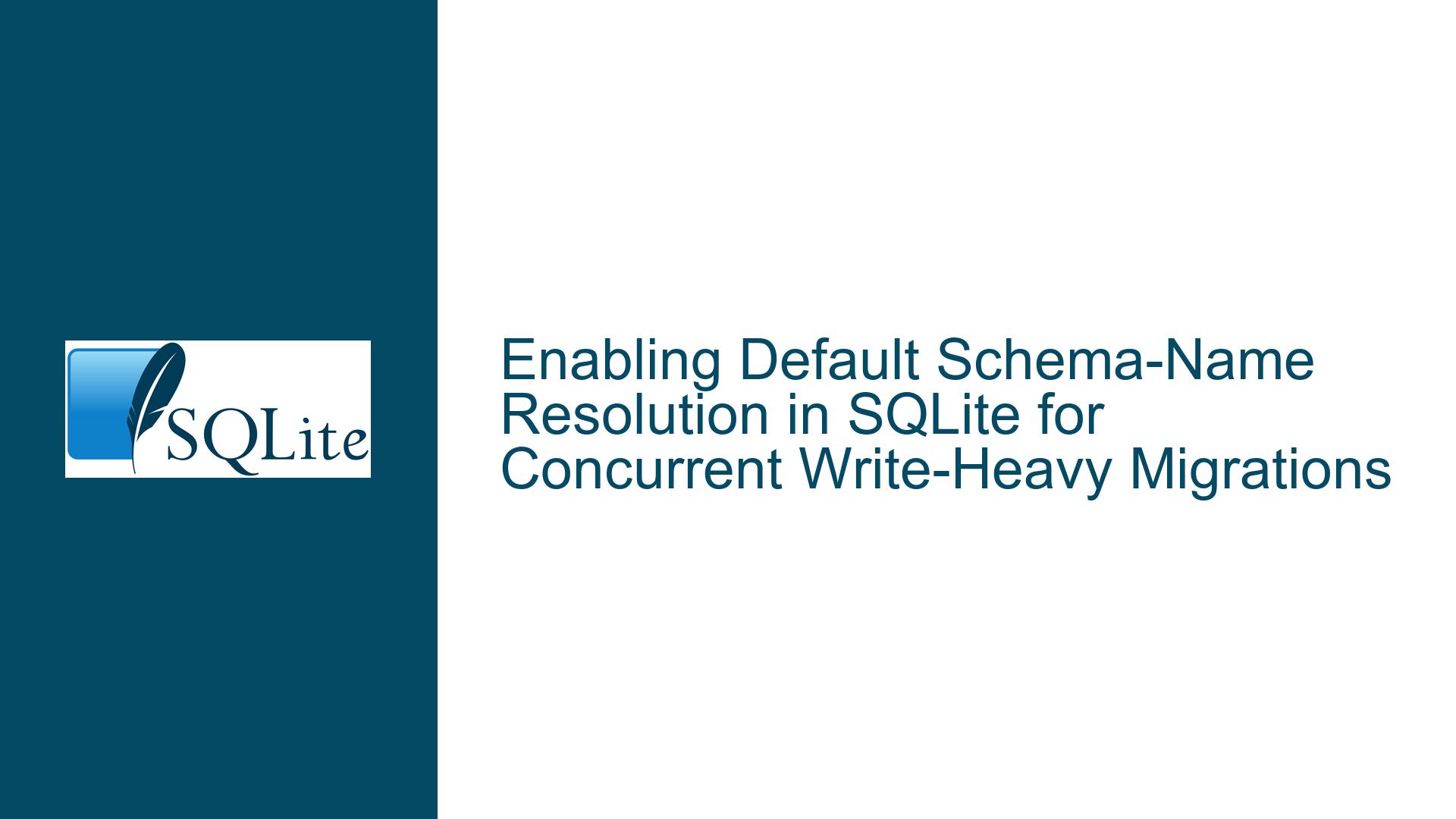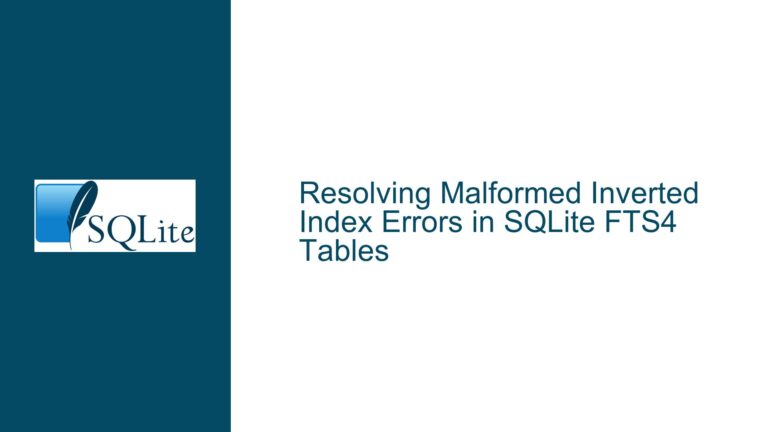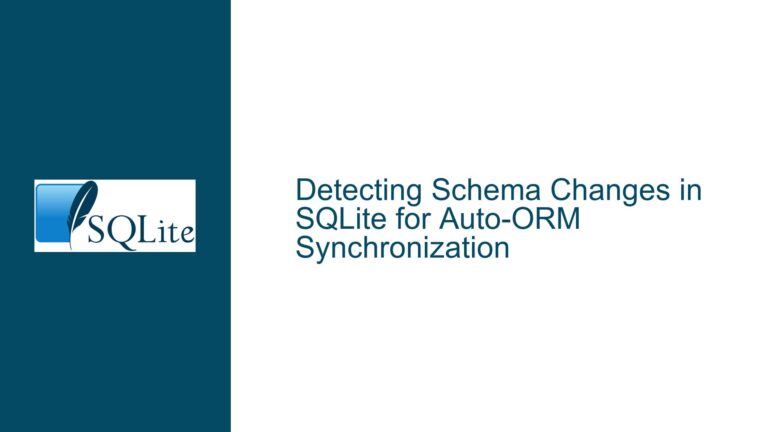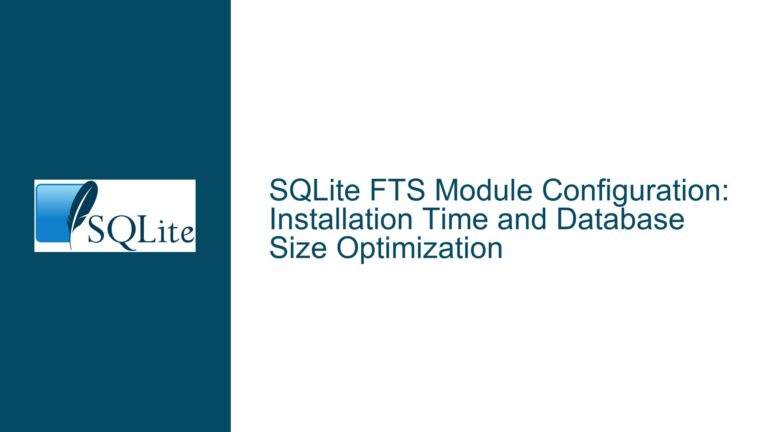Enabling Default Schema-Name Resolution in SQLite for Concurrent Write-Heavy Migrations
Understanding the Need for Default Schema-Name Resolution in SQLite
SQLite is a lightweight, serverless database engine that is widely used for its simplicity and efficiency. However, unlike more complex database systems like PostgreSQL or MySQL, SQLite lacks a built-in mechanism to set a default schema-name for a connection. This limitation becomes particularly evident in scenarios involving concurrent write-heavy migrations, where multiple database files are involved, and queries need to be routed dynamically between them.
In a typical migration scenario, you might have a primary database (db0) and a secondary database (db1) that is being used to create a new index or perform other migration tasks. The goal is to allow writes to db0 to continue uninterrupted while the migration is in progress. To achieve this, you would need to "proxy" queries through db1 to db0, ensuring that any mutations made to db0 are also reflected in db1 via temporary triggers. However, without a default schema-name resolution mechanism, this process becomes cumbersome, as the application would need to generate qualified queries (INSERT db0.t1 (a) VALUES ("foo")) instead of unqualified ones (INSERT t1 (a) VALUES ("foo")). This is especially problematic when using ORMs or web application frameworks that do not support dynamic query generation with schema prefixes.
Exploring the Limitations of SQLite’s Current Schema Handling
SQLite’s current schema handling mechanism is based on a fixed search order for unqualified identifiers: temp, then main, and finally any other attached databases in the order they were attached. This means that if you have a connection where db1 is the main database and db0 is an attached database, any unqualified query will always resolve to db1 first, even if you intend for it to apply to db0. This behavior is problematic in the context of concurrent write-heavy migrations, where you need to ensure that writes are directed to db0 while the migration is ongoing.
The sqlite3_db_config function provides a way to rename the main database, which could theoretically be used to work around this limitation. However, this approach requires that all queries be qualified with the appropriate schema-name, which is not always feasible, especially when using ORMs or frameworks that do not support dynamic schema-name resolution. Additionally, this approach does not provide a way to change the search order for unqualified identifiers, which is necessary to ensure that queries are routed correctly during the migration process.
Implementing a Solution for Default Schema-Name Resolution
To address the limitations of SQLite’s current schema handling, a new PRAGMA statement could be introduced to allow developers to set a default schema-name for a connection. This PRAGMA would change the search order for unqualified identifiers, allowing queries to be routed dynamically between multiple databases without requiring changes to the application’s query generation logic.
For example, consider a scenario where you have a connection to db1 with db0 attached. By setting the default schema-name to db0, any unqualified query would resolve to db0 instead of db1. This would allow you to "proxy" queries through db1 to db0 without requiring changes to the application’s query generation logic. Additionally, temporary triggers could be used to ensure that any mutations made to db0 are also reflected in db1, allowing the migration to proceed concurrently with application writes.
The implementation of this PRAGMA would involve modifying SQLite’s query resolution logic to respect the default schema-name setting. When a query is executed, the database engine would first check the default schema-name setting and use it to resolve any unqualified identifiers. If no default schema-name is set, the engine would fall back to the current search order (temp, then main, then any attached databases).
This approach would provide a flexible and efficient way to handle concurrent write-heavy migrations in SQLite, without requiring changes to the application’s query generation logic. It would also make SQLite more consistent with other database systems like PostgreSQL and MySQL, which already provide mechanisms for setting a default schema-name.
Detailed Troubleshooting Steps, Solutions & Fixes
Step 1: Assessing the Current Schema Handling Mechanism
Before attempting to implement a solution, it is important to thoroughly understand SQLite’s current schema handling mechanism. This involves examining how unqualified identifiers are resolved and how the sqlite3_db_config function can be used to rename the main database. By understanding these mechanisms, you can identify the specific limitations that need to be addressed and determine whether a new PRAGMA statement is the best solution.
Step 2: Designing the Default Schema-Name PRAGMA
The next step is to design the new PRAGMA statement that will allow developers to set a default schema-name for a connection. This involves determining the syntax and behavior of the PRAGMA, as well as how it will interact with SQLite’s existing query resolution logic. The PRAGMA should be designed to be as intuitive and consistent as possible with SQLite’s existing features, while also providing the flexibility needed to handle complex migration scenarios.
Step 3: Modifying SQLite’s Query Resolution Logic
Once the PRAGMA has been designed, the next step is to modify SQLite’s query resolution logic to respect the default schema-name setting. This involves updating the code that resolves unqualified identifiers to first check the default schema-name setting and use it to resolve the identifier. If no default schema-name is set, the code should fall back to the current search order (temp, then main, then any attached databases). This modification should be made in a way that minimizes the impact on SQLite’s performance and stability.
Step 4: Testing the New PRAGMA Statement
After modifying SQLite’s query resolution logic, the next step is to thoroughly test the new PRAGMA statement to ensure that it works as expected. This involves creating test cases that cover a variety of scenarios, including concurrent write-heavy migrations, and verifying that the PRAGMA correctly routes queries between multiple databases. It is also important to test the PRAGMA in conjunction with other SQLite features, such as temporary triggers, to ensure that it does not introduce any new issues or limitations.
Step 5: Documenting the New PRAGMA Statement
Once the PRAGMA has been tested and verified to work correctly, the final step is to document it in SQLite’s official documentation. This involves writing clear and concise documentation that explains the purpose and behavior of the PRAGMA, as well as providing examples of how it can be used in practice. The documentation should also include any relevant caveats or limitations, as well as guidance on how to use the PRAGMA in conjunction with other SQLite features.
Conclusion
The lack of a default schema-name resolution mechanism in SQLite can be a significant limitation in scenarios involving concurrent write-heavy migrations. By introducing a new PRAGMA statement that allows developers to set a default schema-name for a connection, SQLite can provide a more flexible and efficient way to handle these scenarios, without requiring changes to the application’s query generation logic. This approach would make SQLite more consistent with other database systems and provide a valuable tool for developers working on complex migration tasks.






